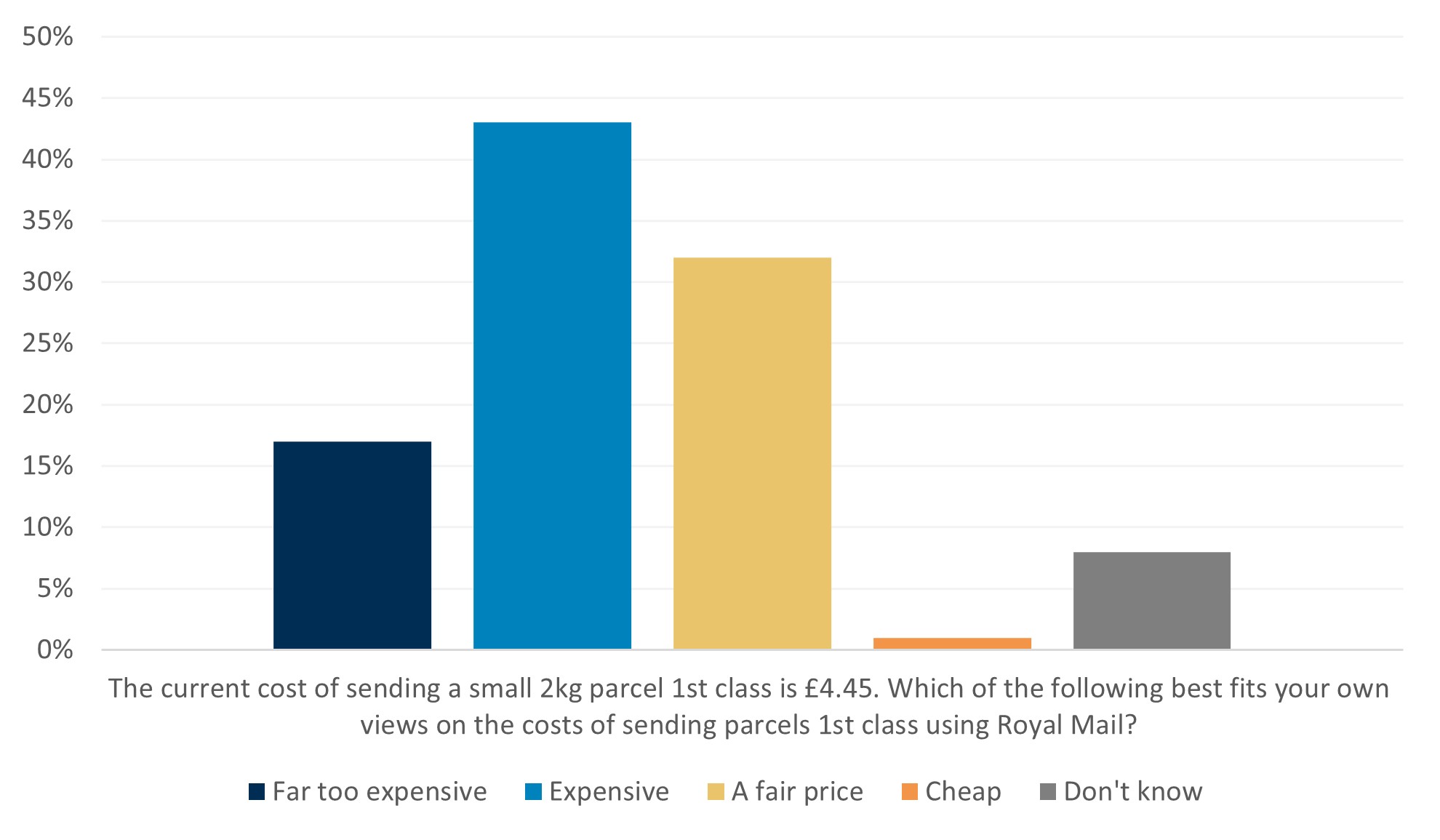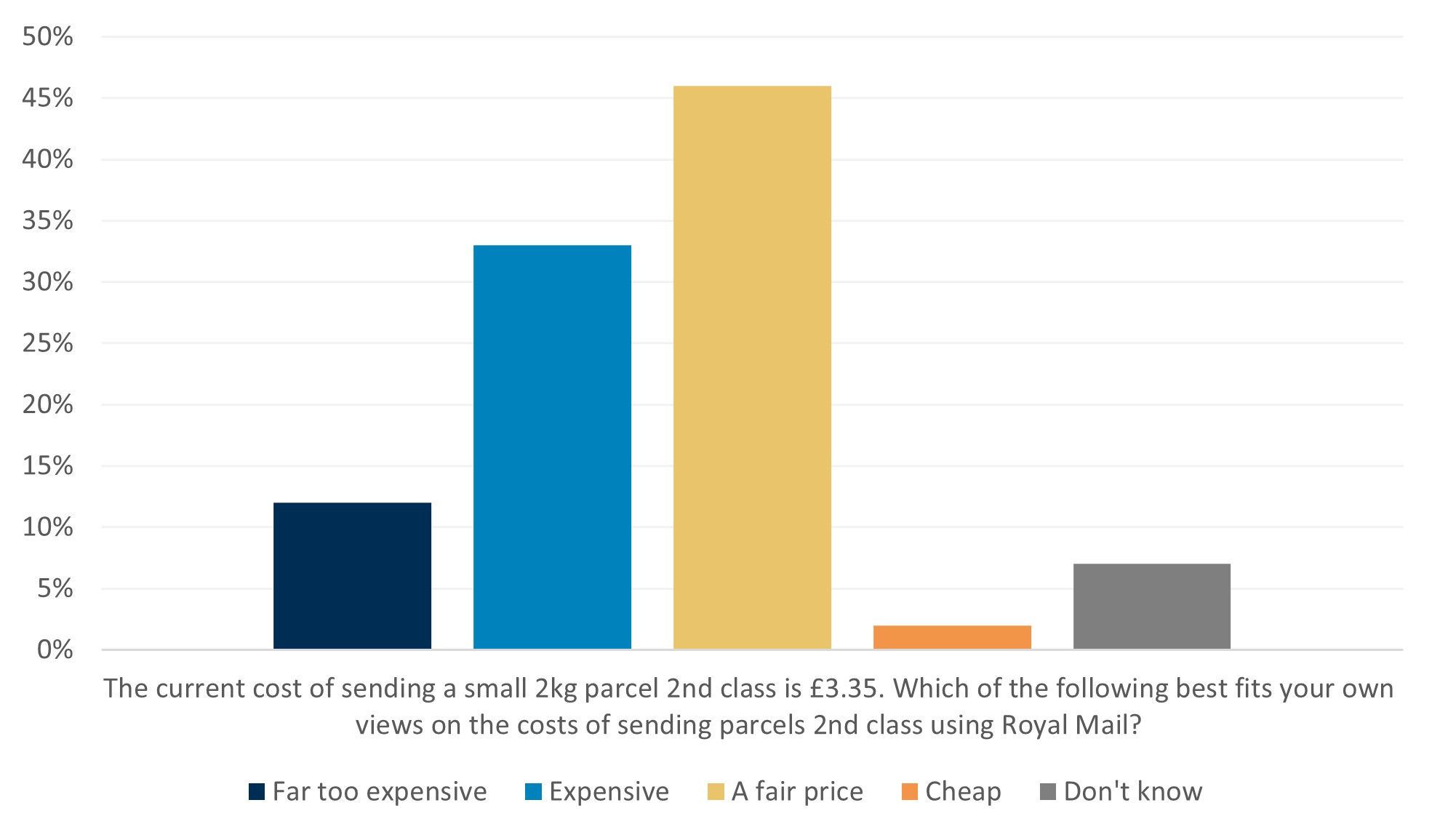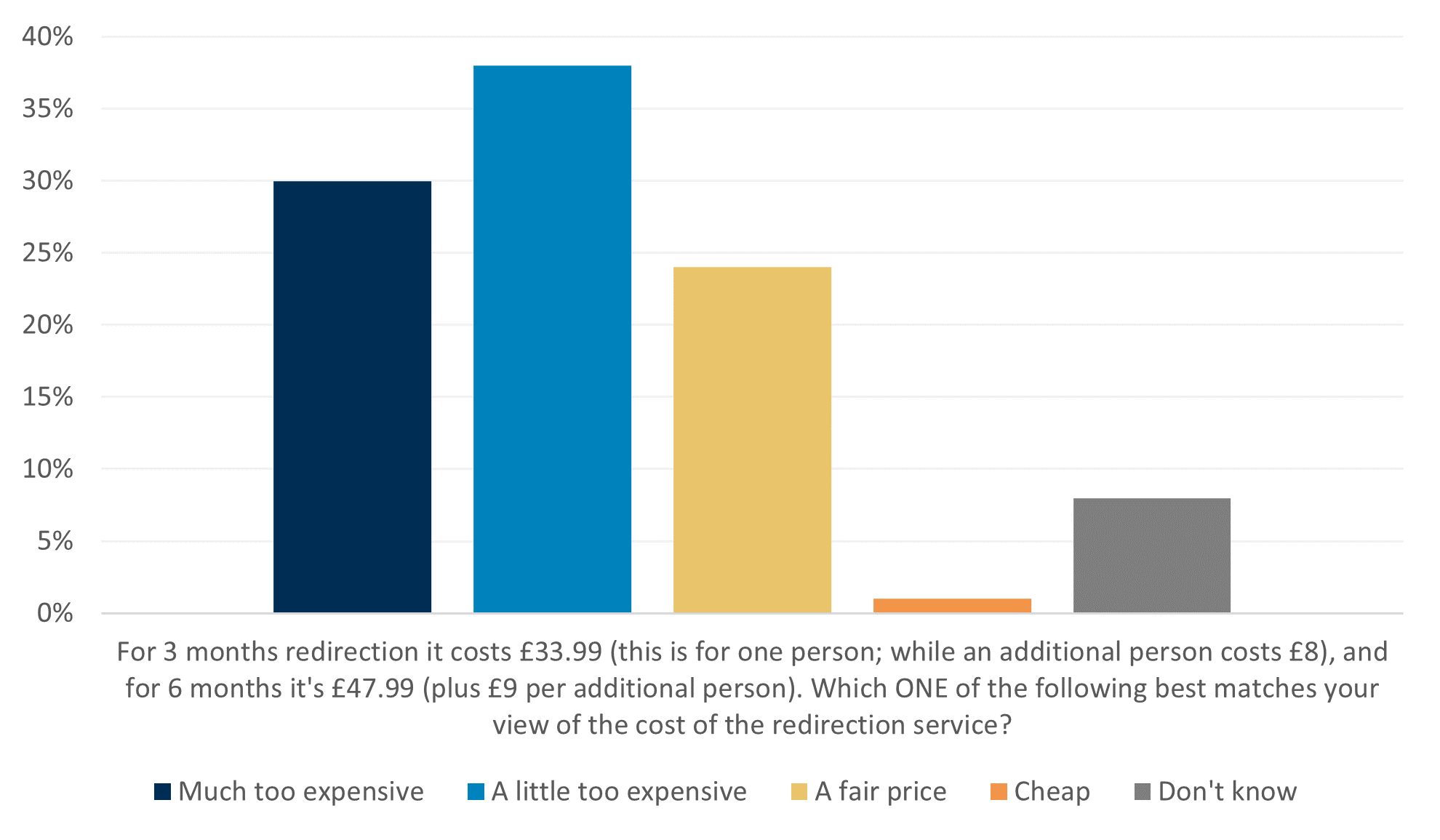1. Who we are
Consumer Scotland is the statutory body for consumers in Scotland. Established by the Consumer Scotland Act 2020, we are accountable to the Scottish Parliament.
The Act defines consumers as individuals and small businesses that purchase, use, or receive products or services.
Our purpose is to improve outcomes for current and future consumers and our strategic objectives are:
- to enhance understanding and awareness of consumer issues by strengthening the evidence base
- to serve the needs and aspirations of current and future consumers by inspiring and influencing the public, private and third sectors
- to enable the active participation of consumers in a fairer economy by improving access to information and support
Addressing the challenges faced by consumers in relation to the cost of living and climate change, and those in vulnerable circumstances, are themes that run throughout our work.
2. Summary and overview
The Postal Services Act 2011 sets out a range of postal services that must be provided at affordable prices for consumers in the UK.[1] There is no specific definition of affordability included within the Act.
Our research, reported in this briefing, indicates that at present many consumers in Scotland regard key postal services, including sending letters and parcels and paying for redirection services via Royal Mail, as expensive.
Our analysis has also identified that there is a minority of consumers for whom paying for postal services is particularly challenging. Access to vital postal services for these consumers appears to be impacting upon their ability undertake other essential expenditure.
These findings should be considered in the context of other factors that are impacting upon the overall consumer experience of and affordability of postal services.
Firstly, since our research was carried out, prices for posting letters in the UK have been increased by between 10 and 15%. It is therefore likely that paying for postal services has become even more challenging for some consumers in Scotland than the figures set out in this briefing.
Secondly, it is important that regulators and policymakers consider the price of postal products alongside the range of other cost of living pressures that consumers in Scotland are experiencing. Separate research carried out by Consumer Scotland has found that one-third of consumers in Scotland are not managing well financially.[2] An understanding of the significant, wider financial pressures facing many consumers should form an important part of any assessment about the future affordability of postal services.
There is a particular relationship between postal services and other communications markets, which together ensure consumers receive the information they need. In this regard, affordability for consumers, particularly those in vulnerable circumstances, should be considered holistically. This consideration should take into the account the extent to which consumers are able to access other communications markets, and affordability protections within these, to ensure vital, affordable lifeline services are available for all consumers.
Finally, issues of affordability for postal services should also be considered in the context of the quality of service being provided to consumers and the value for money that consumers receive. Currently, postal consumers in Scotland are receiving a poorer standard of service than those set out by the regulator. Royal Mail is required to meet specific targets regarding the delivery of key postal services, including delivery times for first and second class post. Royal Mail has not consistently met some of its Universal Service Obligation targets, for example for first class delivery each year since 2017-18,[3] and Ofcom is currently undertaking an investigation into the quality of service provided to consumers.
Ofcom is consulting on its review second class safeguard caps. Consumer Scotland will use the evidence set out in this briefing to inform our response to the consultation.[4]
3. Key Research Findings
Why Postal Services Matter
Postal services can be a vital communications lifeline for consumers. If consumers are not online, or if telephony services are not available, post may be the primary, or only, way that consumers can communicate with the businesses and public services that they engage with. This may include communications regarding essential services, such as healthcare, finance, or social security.
Our research found that the postal market remains an important service for consumers in Scotland. Around two thirds of participants (65% First Class, 62% Second Class) report that they send personal letters, such as letters or cards to friends and family, or send formal correspondence to service providers such as banks.[5] Three-quarters of adults in Scotland (78%) report that they send parcels.
During the past 12 months, consumers who had sent letters in Scotland had sent them predominantly to family and friends, however there remains a significant number of people who said they also sent letters to publics services such as government departments or local authorities.
Chart 1: Letters are most commonly sent to family and friends
Destinations of letters sent by respondents in the last 12 months, and percentage of respondents who sent letters to each destination

The data indicates that for many consumers in Scotland the main reasons for using the postal service are for communicating with family and friends around significant events or for personal correspondence. However, for some consumers it is clear that the postal service also remains an important channel for engaging with government institutions, public services, financial services, insurance providers, utility companies and the welfare benefits system.
Chart 2: While personal communications are the most commonly sent letters, the postal service is also used for engaging with public and other services
Content of letters sent by respondents, and percentage of responents who report sending each type of content

In addition, although our survey did not cover this, it would seem likely that recent changes regarding the requirement to have photo identification to vote in specific UK elections means that some consumers in Scotland will need to use postal services in the forthcoming period to apply for the relevant identification.
In line with our analysis, previous research by Citizens Advice Scotland in 2021 found that one in three (32%) consumers in Scotland regarded delivery of letters as an essential service.[6] This was supported by Citizens Advice research where 40% of GB consumers found letter delivery helpful, and in addition, 32% of consumers thought that it was essential to receive letters through the post.[7]
Postal services can be particularly important for certain groups of consumers. Specifically, our research found differences in use of postal services between rural and urban consumers in Scotland: [8]
Chart 3: Rural consumers are more likely to send certain types of letters than urban consumers
Percentage of consumers sending selected types of letters, for consumers in urban and rural areas

Postal services are also particularly important to consumers in vulnerable circumstances, for example, due to health conditions or low income. Consumers who are disabled or with a long term health condition are significantly more likely than average in Scotland to send letters to organisations or bodies such as local authorities, GPs or other healthcare professionals, or government departments.
Separate research by Citizens Advice aligns with these findings. It found that, across Great Britain, remote rural consumers (50%), those with a mental health condition (48%), those aged 75+ (42%) and non-internet users (38%) were the most likely groups to state that receiving post was essential. They also found that 1 in 2 (49%) would find it harder to manage their health and 3 in 10 (30%) would find it harder to manage their finances if they could not receive post.[9] Ofcom’s research found that more than two thirds of people (69%) consider post to be essential or fairly important as a channel of communication. Those aged 55+ are more likely to say that post is important to them (73%) as are those who are housebound (77%).[10]
Affordability of sending letters and parcels
Consumer Scotland sought to establish the views of consumers on the affordability of the postal service. Our research used 2022 prices that were in places prior to Royal Mail announcing an increase in the price of postal services from April 2023. Those increases included a 15% increase for a first class stamp to £1.10 and 10% increase to 75p for second class stamp.[11]
Our research, found that even prior to these changes, over half of consumers in Scotland believed that the prices for first and second class stamps were expensive:
- 7 in 10 (68%) said first class stamps (95p) were ‘far too expensive’ or ‘expensive’[12]
- 1 in 4 (25%) said first class stamps were ‘a fair price’ and 1% said they were ‘cheap’[13]
- 1 in 2 (53%) said second class stamps (68p) were ‘far too expensive’ or ‘expensive’[14]
- 4 in 10 (40%) said second class stamps were ‘a fair price’ and 2% said they were ‘cheap’[15]
Chart 4: Most consumers think first class stamps are expensive
Consumers’ views on the cost of sending letters 1st class using Royal Mail

Chart 5: Just over half of consumers think second class stamps are expensive
Consumers’ views on the cost of sending letters 2nd class using Royal Mail

A significant proportion of consumers in Scotland also indicated that they regarded the price of sending parcels via Royal Mail as expensive:
Chart 6: Most consumers think the cost of sending a 1st class parcel is expensive
Consumers’ views on the cost of sending a 2kg 1st class parcel using Royal Mail

Chart 7: Less than half of consumers think the cost of sending a 2nd class parcel is expensive
Consumers’ views on the cost of sending a 2kg 2nd class parcel using Royal Mail

For some consumers in Scotland, the price of sending letters and parcels appears to be particularly challenging. Nearly 1 in 5 (19%) said they would find it difficult to afford to buy a book of second class stamps next week (priced at £5.44).[18] Meanwhile, 15% of those who send letters or parcels said they struggled to afford postal services in the last 12 months[19]. Amongst these consumers just more than a quarter (28%) reported having to forgo paying for or using essentials such as food or energy in order to pay for postage.[20]
For some parcel products, there may be particular affordability challenges for specific groups of consumers. Currently Royal Mail offer an online-only price for conveying a small 2nd class parcel under 2kg at £2.99, while it is £3.49 for those who must purchase the service in person from a Post Office. For these parcel services, there is therefore a premium being paid by consumers who are not able to make this purchase online, which may include those who do not have access to decent quality telecommunications services or adequate digital literacy. Ofcom’s Connected Nations Report for Scotland estimates there remain 21,000 homes and businesses in Scotland without access to a “decent broadband connection,” while 8,000 premises are not able to receive decent broadband or “good indoors 4G coverage.”[21] This pricing structure may disadvantage consumers who may require in-person assistance to send a package through a local post office.
In this context, we note the interrelationship between postal services and other communications markets, such as broadband services. Ofcom’s recent research on communications affordability found that only 5.1% of eligible households receiving universal credit are currently accessing a social tariff for broadband services. This contrasts with data which shows that three in ten (29%) of UK households are experiencing difficulty in paying for their communications services.[22]
Affordability of redirection services
In 2022-23, consumers were charged a fee of £33.99 to redirect post for a 3-month period. This cost increased to £36 from April 2023.
Royal Mail offers a concessionary rate scheme for redirection services for consumers in receipt of specific benefits. This scheme was expanded in November 2021, increasing the level of discount available and broadening coverage to include a wider range of benefits. The scheme received a total of 4,700 applications across the UK in 2022-23.[23]
As part of its Review of Postal Services, Ofcom gathered evidence during 2021 on the affordability of redirection services.[24] It found that 3 in 10 customers would not be able to afford to use the service at the price of £33.99 for 3 months.
Consumer Scotland's research found that 3 in 10 consumers (30%) in Scotland regard the standard redirection product as much too expensive, while a further 38% regard this service as a little too expensive.[25] This is particularly true for those on lower incomes, with 73% of those with a gross household income under £20,000 regarding this service as too expensive. Those consumers with a disability or long term health condition were also more likely to say that redirection was too expensive, with only 1 in 5 of these consumers saying that the product was a fair price or cheap.
Chart 8: Most consumers think standard redirection services are much or a little too expensive
Consumers’ views on the cost of Royal Mail’s redirection services

Building on the expansion of the redirection concessionary scheme in recent years, consideration is required as to how to ensure that redirection services are affordable for all consumers; and to ensure all those who may benefit from the concessionary rates are aware of, and take up, these discounts.
4. Endnotes
[1] Postal Service Act 2011, Section 31 Minimum Requirements: Postal Services Act 2011 (legislation.gov.uk)
[2] Consumer Scotland: Consumer Spotlight: Energy Affordability Tracker 2 | Consumer Scotland
[3] House of Commons - Business, Energy and Industrial Strategy Committee: Royal Mail and the Post Office (parliament.uk)
[4] Postal Service Act 2011, Section 31 Minimum Requirements: Postal Services Act 2011 (legislation.gov.uk)
[5] Q1. For the following question, by 'personal letters', we mean any letters addressed to an individual/person, this could be anything from a birthday card to formal correspondence with a bank. How often, if at all, do you send... Base: All (n=2,007)
[6] Citizens Advice Scotland, Postal Services in Scotland: Postal Services in Scotland | Citizens Advice Scotland (cas.org.uk)
[7] Citizens Advice, State of the Sector: State of the Sector report (citizensadvice.org.uk)
[8] Q9. Thinking about the letters you send, what are you sending? (Tick all that apply). Base: All that have sent letters (n=1,443).
[9] Citizens Advice, State of the Sector: State of the Sector report (citizensadvice.org.uk)
[10] Ofcom, Communications Market Report 2023: Communications Market Report 2023 (ofcom.org.uk)
[11] Royal Mail, Prices 2023: Prices 2023 | Royal Mail Group Ltd
[12] Q12a. The current cost of a 1st class stamp for a letter is 95p. Which of the following best fits your own views on the costs of sending letters 1st class. Base: All (n=2,007)
[13] Q12a. The current cost of a 1st class stamp for a letter is 95p. Which of the following best fits your own views on the costs of sending letters 1st class. Base: All (n=2,007)
[14] Q12b. The current cost of a 2nd class stamp for a letter is 68p. Which of the following best fits your own views on the costs of sending letters 2nd class. Base: All (n=2,007)
[15] Q12b. The current cost of a 2nd class stamp for a letter is 68p. Which of the following best fits your own views on the costs of sending letters 2nd class. Base: All (n=2,007)
[16] Q16a. The current cost of sending a small 2kg parcel 1st class is £4.45. Which of the following best fits your own views on the costs of sending parcels 1st class using Royal Mail? Base: All (n=2,007)
[17] Q16b. The current cost of sending a small 2kg parcel 2nd class is £3.35. Which of the following best fits your own views on the costs of sending parcels 2nd class using Royal Mail? Base: All (n=2,007)
[18] Q15. 2nd class stamps are usually sold in a book of 8. This costs £5.44. If you had to buy a book of 2nd class stamps next week, how easy or difficult would it be for you to afford this? Base: All (n=2,007)
[19] Q13. Thinking about the last 12 months, have you struggled at any time to afford using postal services? Base: All (n=1,738)
[20] Q14. Did you have to forgo using or paying for essentials, such as food or energy, to pay to use postal services? Base: (n=260)
[21] Ofcom, Connected Nations 2022, Nations reports - Ofcom
[22] Ofcom, Affordability of communications services April 2023 update: Affordability of communications services – April 2023 update
[23] Royal Mail, ESG Report 2023: rmg-2022-23-esg-report.pdf (internationaldistributionsservices.com)
[24] Ofcom, evidence on redirection: Redirection affordability research chart pack (ofcom.org.uk)
[25] Q22. For 3 months redirection it costs £33.99 (this is for one person; while an additional person costs £8), and for 6 months it's £47.99 (plus £9 per additional person). Which ONE of the following best matches your view of the cost of the redirection service? Base: All (n=2,007)